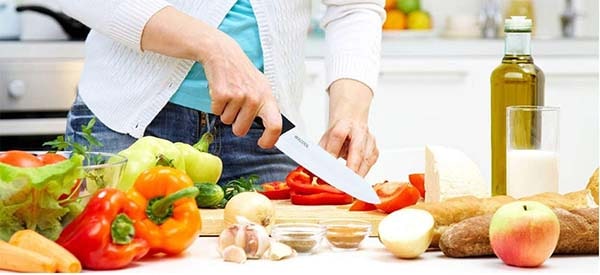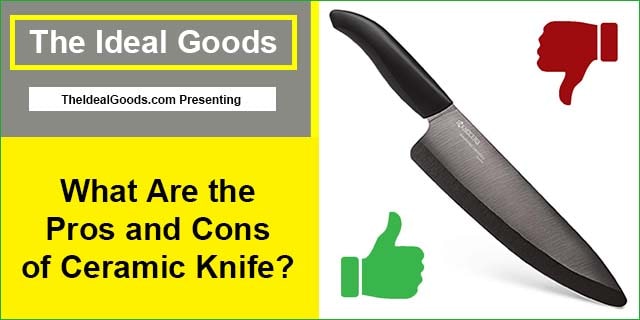A chef uses different types of knives to cut different types of food ingredients at home or in the kitchen. The blades of these kitchen knives are mainly made of two materials, one is steel and the other is ceramic.
But there are many of us who do not have a detailed idea of what ceramic knives are, what these knives are used for, and their pros and cons. In this article, I will cover those topics in detail.
If you want to buy a ceramic knife or set after reading the details, I have a “Best Ceramic Knife Set” review article on this blog, you may want to check it out.
How Are Ceramic Knives Made?
Ceramic is a very broad term and describes a wide variety of non-metallic materials. These are made from the ceramic material zirconium oxide. The material of good ceramic knives is particularly fine and of high quality.
During production, the powdered zirconium oxide is pressed into prefabricated forms and baked for a set period of time under high pressure and extreme heat. The ceramic blade is then finely polished.
As a result, the knives are very light on the one hand, but also extremely hard on the other hand and they are extremely sharp. They also don’t have to be sharpened as often.
What Are Ceramic Knives Used for?
Ceramic knives are particularly suitable for cutting or peeling fruit, vegetables, filleting boneless meat, and fish without bones.
In general, the blade of ceramic knives is super sharp so it is highly effective for cutting or slicing soft food ingredients.

What Are the Pros or Advantages of Ceramic Knives?
Ceramic knives have several advantages. Let me describe some major pros about it-
Pros-1: Strength
First of all, this material is much lighter but still extremely hard. Its hardness is comparable to that of a diamond.
Ceramic material is also used, for example, in space travel, for heat shields of space rockets. This high-tech ceramic is also used in medicine. Among other things, artificial hip joints and knee joints or leg prostheses are made from them.
Ceramic kitchen knives are not only particularly light and also pretty to look at and last ten times longer than metal knives.
Pros-2: Durability
Secondly, high-quality industrial ceramics are extremely insensitive to acids, rust, and almost all other chemical and thermal influences.
Because ceramic knives are manufactured under tremendous pressure and temperatures of up to 1,200 degrees Celsius, they will remain sharp for many years if handled properly.
Pros-3: Versatility
With a good quality ceramic knife, you can cut soft and flexible but also very hard products in the same way. Ceramic knives have the most advantages for foods with a lot of acids.
In addition, they do not cause allergies, are very hygienic and easy to clean as well as the knives are rustproof.
Pros-4: Edge Retention
Ceramic knives lose their sharpness over time. If the ceramic knives are used properly, they will keep their sharpness over 10 times longer than simple kitchen knives, based on correct handling.
Pros-5: Resistant to Germs and Odors
Two other special advantages of ceramic knives are their taste neutrality and allergy suitability. It also means when cutting fruits, oxidation would not occur immediately.
The ceramic blade is absolutely germ-resistant because it does not contain any allergenic components such as nickel.
Thanks to its special surface finish, cutting with it does not affect the taste or odors of vegetables, fruit, and meat.
Pros-6: Resistant to Discoloration
Fortunately, discoloration of the kitchen tools is also ruled out. The ceramic kitchen knife can easily be cleaned with washing-up liquid and is usually even dishwasher-safe.
What Are the Cons or Disadvantages of Ceramic Knives?
Cons-1: Brittle Than Steel
One disadvantage is that ceramic is much more brittle than steel. This makes it easier to break, for example, if you accidentally drop it on a stone floor or something similar.
However, the resistance to breakage of ceramic knives has increased significantly in recent years compared to the early days.
Cons-2: Not Suitable for Heavy Use
Nevertheless, half tang ceramic knives should not be used for chopping, boning, or cutting deep-frozen products; steel knives are better suited here.
Cons-3: Difficult to Sharpen
Another small disadvantage of ceramic knives is that you cannot easily sharpen them yourself. They cannot be processed with the usual knife grinders.
With a steel blade, the edge “rolls” to the side when it becomes blunt. Hard ceramic blades hold their sharp edge longer, but are more sensitive if used incorrectly and tend to break rather than “roll”.
You May Like: Best Self Sharpening Cutlery Sets
Cons-4: Handle and Tang
In most cases, ceramic knives are designed as half tang, and their handles are made with plastic. It is often seen that the handle of the knife is almost falling off or breaking due to the half tang.
Cons-5: Edge Chipping
Over time, however, small stones in the cuttings, hard food, bones, or incorrect use will form small, barely visible chippings in the cutting edge of the ceramic blade.
This is normal for all hard materials and happens for example with Damascus steel knives.
The small breakouts do not yet mean that the knife is blunt. If the blade of a ceramic knife has become dull after a long period of use, you have to take it to a professional sharpener. Professional sharpening service can often even out larger chippings.
For sharpening ceramic knives and other high-quality kitchen knives, many companies have developed different types of knife sharpening systems that are suitable for keeping sharp edges and re-sharpening of your kitchen knives at your home. Even small breakouts can be removed with the knife sharpening systems.
Final Verdict
Undoubtedly, ceramic knives are useful for a variety of food. In addition to that, the usage of this ceramic knife is not complicated at all.
